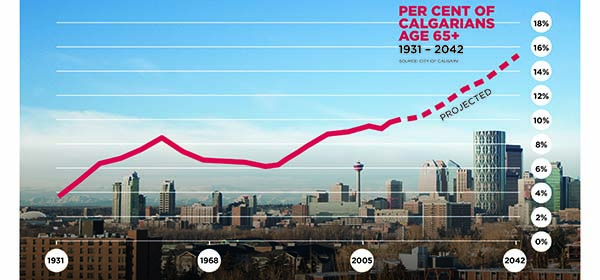
Senior population in Calgary
Oct. 30, 2015 | Cody Stuart
Seniors shortage
New initiative highlights growing housing concernThe City of Calgary has embarked on a three-year strategy to develop a more "age-friendly" city in light of some estimates that have the local senior population nearly doubling within the next decade.
Dubbed the Seniors Age-Friendly Strategy, the plan calls for the creation of community networks focused on issues such as housing, transportation and mobility.
Proposed actions include increasing the provincial standard for provincially funded affordable housing from 10 to 15 per cent, advocating for sustainable provincial funding for the development of new affordable housing and introducing a Land Use Bylaw Amendment to allow for more secondary suites.
Housing, in fact, represents just one of six age-friendly priorities identified by the City. Over the next three years, the City also plans to work on increasing access to information and services, improving community support and health infrastructure, as well as increasing the level engagement through better participation and inclusion.
The plan also calls for better responses to curb elder abuse, and improvements to transportation and mobility challenges.
"Building relationships and networks is going to be the way we are able to best respond to the needs of an aging population," said Katie Black, director with Community & Neighbourhood Services. "When we plan our services and physical environments with this population in mind, we create an inclusive and accessible city for all of us to be as healthy and active as possible as we age.
"I've been so excited to see the collaborative spirit demonstrated by everyone who is working on this. There is a strong belief in the importance of this work and among all the partners involved, and today has been a great celebration of what we will be able to do together."
According to the City, the number of Calgarians over the age of 65 will increase from 120,216 in 2014 to 166,000 in 2024 and 226,000 in 2034. The City says the population over the age of 65 will become the fastest-growing age group, with a growth rate that is twice as high as the total population.
In its Changing Face of Calgary report released earlier this year, Urban Development Institute – Calgary and the Canadian Home Builders' Association – Calgary Region suggested that by 2036, for the first time in the city's history, the number of adults over the age of 65 will surpass the number of children under 14.
Silvera for Seniors CEO Arlene Adamson applauds calls for increased support to Alberta's aging population.
"Respect for all generations is a must, this includes seniors. This strategy, we hope, will now make seniors a priority the time is now to be ready for our city's population to age," said Adamson whose Calgary-based non-profit provides affordable housing to more than 1,500 lower-income seniors in the city.
"Immediate attention to help this city catch up with the current demand is necessary both from local government and provincial government. Supports also to expedite land development processes to help not for profit build quicker and at less cost would also help us be ready to serve/house seniors."
The City's strategy, which was released earlier this year, underlines growing concerns as to whether municipalities such as Calgary are properly prepared to handle growing senior populations. A recent Federation of Canadian Municipalities (FCM) report predicted the number of seniors in the country will hit 10.4 million by 2036, double the level seen in 2011. The most rapid increase was in the 85-plus category.
Titled Seniors and Housing: The Challenge Ahead, the FCM report states Canada's seniors are facing "a perfect storm," with rent at seniors' residences reportedly costing 2.5 times the national average and nearly 700,000 senior households facing an affordability challenge.
"This report should be a wake-up call to any federal party that is serious about strengthening the economy," said FCM president Raymond Louie in the report. "It presents striking evidence that the crisis in housing is real and it's growing. Municipalities are working on solutions to protect Canadian families but we need a federal partner to join us."
Earlier this year, the Organisation for Economic Co-operation and Development (OECD) unveiled its 2015 Ageing in Place report, which used Calgary as one of nine case studies along with cities such as Toyama, Japan and Helsinki, Finland.
In it, the OECD pointed to affordable housing as a vital part to aging in Calgary, yet noted the city has not done enough to bridge the gap between supply and demand. It said eligibility for affordable housing has historically hovered around 18 per cent, yet current supply is only around 2.5 per cent.
"As Calgary's population continues to increase, the demand for affordable housing will continue to grow and the gap in the housing system is likely to widen," said the OECD.
The global organization did, however, recognize the City's current Community Affordable Housing Strategy, which is focusing on providing affordable housing to households earning less than 65 per cent of the median income that spend more than 30 per cent of housing, regardless of their demographic.
Tagged: aging in place | Calgary Real Estate News | CHBA | City of Calgary | OECD | seniors | UDI




